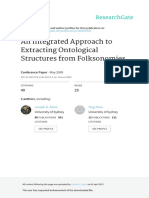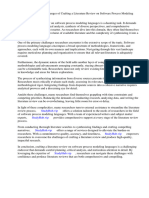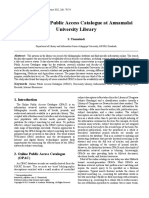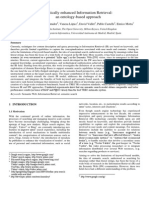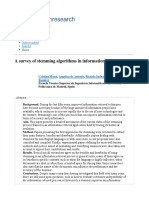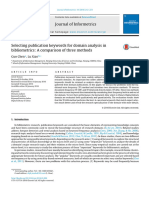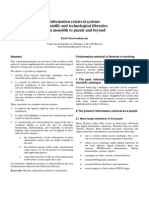Searchling: User-Centered Evaluation of A Visual Thesaurus-Enhanced Interface For Bilingual Digital Libraries
Searchling: User-Centered Evaluation of A Visual Thesaurus-Enhanced Interface For Bilingual Digital Libraries
Uploaded by
Svetlana TîltuCopyright:
Available Formats
Searchling: User-Centered Evaluation of A Visual Thesaurus-Enhanced Interface For Bilingual Digital Libraries
Searchling: User-Centered Evaluation of A Visual Thesaurus-Enhanced Interface For Bilingual Digital Libraries
Uploaded by
Svetlana TîltuOriginal Title
Copyright
Available Formats
Share this document
Did you find this document useful?
Is this content inappropriate?
Copyright:
Available Formats
Searchling: User-Centered Evaluation of A Visual Thesaurus-Enhanced Interface For Bilingual Digital Libraries
Searchling: User-Centered Evaluation of A Visual Thesaurus-Enhanced Interface For Bilingual Digital Libraries
Uploaded by
Svetlana TîltuCopyright:
Available Formats
Searchling: User-Centered Evaluation of a Visual Thesaurus-Enhanced Interface for Bilingual Digital Libraries
Amy Stafford2, Ali Shiri3, Stan Ruecker1, Matthew Bouchard1, Paras Mehta4, Karl Anvik1, and Ximena Rossello1
Humanities Computing Program Department of English and Film Studies 3 School of Library and Information Studies 4 Faculty of Medicine University of Alberta {als2,ashiri,sruecker}@ualberta.ca, {matt.bouchard@gmail.com}
2 1
Abstract. In this paper, we describe a qualitative user study of Searchling an experimental visual interface that allows users to leverage a bilingual thesaurus for query formulation and enhancement. The design of Searchling is based on theories of thesaurus-based interface design from Shiri et al. [1], combined with the principles of rich-prospect browsing [2]. The Searchling interface provides the user with three working spaces on one screen: the Thesaurus space, Query space, and Document space. We interviewed 15 graduate and faculty researchers at the University of Alberta, who carried out three structured tasks in a thinkaloud protocol, with simultaneous audio recording and screen capture. These participants identified a number of significant advantages to the researcher provided by Searchling, including the value of having an interface that could help with identifying search terms, suggesting preferred terms, and giving bilingual search support. They also suggested areas for future improvement, primarily related to our assumption that common knowledge of thesauri would be sufficient to make the various features clear if they were described using standard vocabulary from the thesaurus field. Keywords: Visual Interfaces, Thesauri, Multilingual Digital Libraries, Information Retrieval, User Evaluation.
1 Introduction
Visual interfaces are finding their way into digital libraries as well as into a wide range of information retrieval systems. Visual interfaces enhanced with a thesaurus can be designed to support a variety of information seeking tasks, namely searching, browsing and navigation. More specifically, depending on the level of sophistication that can be offered in the interface, visual interfaces have the potential to support such interactive tasks as query formulation, modification or expansion. In this project, our aim was to develop and evaluate a thesaurus-enhanced bilingual visual interface that will support users information search and retrieval experience within the context of
B. Christensen-Dalsgaard et al. (Eds.): ECDL 2008, LNCS 5173, pp. 117121, 2008. Springer-Verlag Berlin Heidelberg 2008
118
A. Stafford et al.
digital libraries. For the current phase, we used the Government of Canada Core Subject Thesaurus. Previous research in thesaurus-based query formulation and expansion has shown promising results. For instance, Beaulieu [3] reported that both the explicit and implicit use of a thesaurus (using interactive or automatic query expansion respectively) can be beneficial. Efthimiadis [4] has suggested that during query expansion, a thesaurus could be used to display the relationships of the selected terms to other terms. Shiri and Revie [5] in a study of end-user search term selection and query expansion behaviour within a thesaurus-enhanced search system, found that in 50% of the cases where users found additional thesaurus terms, they were not aware of those terms at the beginning of the search. More recently, Shiri [6] has examined 21 metadata-enhanced digital library visual interfaces from the following perspectives: a) information access and retrieval features supported; b) metadata elements used; c) visualization techniques and metaphors utilized. The results show that visual interfaces to digital libraries enhanced with metadata are becoming more widespread as they provide richer representation of digital collections.
2 Theoretical Framework and Design of Searchling
The design of our user interface, called Searchling, was based on two key concepts. The first is the idea of rich-prospect interfaces, in which individual representations of every item in a collection are combined with emergent tools [2]. Using this conceptual framework, Ruecker et al. have subsequently developed a number of metadata enhanced visual interfaces to support users information search and exploration activities (e.g. [7], [8]). The second set of principles we applied are the design ideas for thesaurus-based search interfaces suggested by Shiri et al. [1], including: Providing hierarchical and alphabetical lists to support different strategies. Allowing flexible ways of choosing terms. Facilitating moving between a descriptor and its hierarchical structure. Catering for the selection of alternative Boolean operators. Providing a term pool option for saving the descriptors. Integrating thesaurus and retrieved documents displays. Making thesaurus options available in all stages of the search process.
The interface provides the user with the following three spaces within a single screen: the thesaurus space, the query space, and the document space (Figure 1). The Thesaurus space is on the left. It includes a browsable side panel of high-level categories, next to a list of thesaurus terms. Each term has a number beside it, which indicates how many documents in the collection contain the term. When a term is queried or clicked, it moves to the top of the list and all related terms from the thesaurus appear below it. The table to the right of the Thesaurus list indicates related terms that are broader, narrower, preferred or non-preferred compared with the selected term; the user can also sort by these categories. Finally, there is a language switch at the top of the Thesaurus list. The Query space is located in the right panel of the screen. Users can search for a single term in the thesaurus by entering it in the query box, choosing a language, and
Searchling: User-Centered Evaluation of a Visual Thesaurus-Enhanced Interface
119
Fig. 1. Searchling v1.1, showing the Thesaurus, Query Formulation, and Document spaces
clicking the button labeled Find in Thesaurus. If the term is entered in English but the user selects French as the query language, Searchling will search for the corresponding French term, but the English term will also always be visible as a microtext satellite below the query term. When users decide to add a term to their query, they do so by checking the box next to it in the thesaurus list, and it is added to the Selected Terms list on the lower right side panel. This area serves as the term pool described by Shiri et al. [1]. The Document space forms the third section of the screen, running across the bottom. The documents are represented by standard bibliographic information; they can be sorted in various ways, and each item serves as a link to the actual document.
3 Methodology
The methodology and the technologies used to develop the visual user interface have been detailed in a previous paper [9]. The focus of this paper is to report on a usercentred evaluation of the interface.
120
A. Stafford et al.
Fifteen participants for this study were recruited by snowball sampling of researchers at the University of Alberta, including in particular the bilingual researchers from the Department of Modern Languages and Cultural Studies. Data from the interviews were collected verbally, digitally and in written form. The tasks in this user study were designed to test the users initial response to the Searchling interface; we were interested in how easy or difficult it is for new users to understand the relationship between the different groups of information on the page and whether they found this grouping helpful in their search. In other words, the assigned tasks asked users to try out as many of the interface features as possible, while requiring very little focus on the actual content of the database. In addition to the qualitative feedback, we also had users rank a number of items on a 5-point Likert scale.
4 Results
The most promising finding for Searchling is that it has the potential to solve the greatest problem that people encounter with other search tools, namely formulating queries. When asked about difficulties with their current search tools, the study participants unanimously cited the inability to isolate keyword search terms for a specific topic as the single most frustrating problem. One participant saw immediate implications for her own research. She studies non-canonical elements, which often use multiple names, so it would be very helpful. Other users said they would find Searchling most useful at the beginning of a research project on an unfamiliar topic, because they could start by browsing through general categories for relevant terms and the Thesaurus could help them narrow or broaden their search. There were also positive responses to specific aspects of the interface, such as the numbers next to each term in the Thesaurus, which indicate how many documents in the collection contain that term. Most users also appreciated that they could keep as many items as they like on deck in the Selected Terms list, without immediately adding them to the search for documents.
References
1. Shiri, A.A., Revie, C., Chowdhury, G.: Thesaurus-Enhanced Search Interfaces. Journal of Information Science 28(2), 111122 (2002) 2. Ruecker, S.: Affordances of Prospect for Academic Users of Interpretively-tagged Text Collections. Ph.D. Dissertation. Edmonton, University of Alberta (2003) 3. Beaulieu, M.: Experiments of interfaces to support query expansion. Journal of Documentation 53(1), 819 (1997) 4. Efthimiadis, E.N.: Interactive query expansion, A user-based evaluation in a relevance feedback environment. Journal of the American Society for Information Science 51(11), 9891003 (2000) 5. Shiri, A., Revie, C.: Query Expansion Behaviour Within a Thesaurus-enhanced Search Environment, A User-centred Evaluation. Journal of the American Society for Information Science and Technology 57(4), 462478 (2006)
Searchling: User-Centered Evaluation of a Visual Thesaurus-Enhanced Interface
121
6. Shiri, A.: The Use of Metadata in Visual Interfaces to Digital Libraries. In: Proceedings of the 11th European Conference on Research and Advanced Technology for Digital Libraries, Budapest, Hungary, September 16-21. LNCS. Springer, Heidelberg (2007) 7. Ruecker, S., Lewcio, M., Plouffe, M., Wynne, M.: I never forget a face, a rich-prospect image browser for conferences. In: The Society for Digital Humanities (SDH/SEMI) conference, May 29-31. York University, Toronto (2006c) 8. Ruecker, S., Given, L., Simpson, H., Sadler, E., Ruskin, A.: Design of a Rich-Prospect Browsing Interface for Seniors, A Qualitative Study of Image Similarity Clustering. Visible Language 41(1), 422 (2007) 9. Shiri, A., Ruecker, S., Rossello, X., Bouchard, M., Mehta, P.: Development of a Thesaurusenhanced Visual Interface for Multilingual Digital Libraries. In: Dalkir, K., Arsenault, C. (eds.) Proceedings of the 35th Annual Conference of the Canadian Association for Information Science, Information Sharing in a Fragmented World, Crossing Boundaries, Montreal, May 10-12 (2007)
You might also like
- Test Bank For Marketing The Core 8th Edition Roger Kerin Steven HartleyDocument40 pagesTest Bank For Marketing The Core 8th Edition Roger Kerin Steven HartleyLance Strasser100% (42)
- The Four Gospels SummaryDocument7 pagesThe Four Gospels Summarynilecruised91% (11)
- Myopic Management - ACCA Qualification - Students - ACCA GlobalDocument4 pagesMyopic Management - ACCA Qualification - Students - ACCA GlobalKyaw Htin WinNo ratings yet
- Zutons - Valerie - BassDocument2 pagesZutons - Valerie - BassMaxlake76No ratings yet
- 2008d Sigirforum MurdockDocument4 pages2008d Sigirforum MurdockrrbgittanNo ratings yet
- Hci Unit 5Document22 pagesHci Unit 5Boddu TejasriNo ratings yet
- Hci Unit 5 PDFDocument22 pagesHci Unit 5 PDFnoolumanikanta0506No ratings yet
- Hybrid Search: Effectively Combining Keywords and Semantic SearchesDocument15 pagesHybrid Search: Effectively Combining Keywords and Semantic SearchesSiti HajarNo ratings yet
- Evaluation of JSTOR DFR: Usability TestingDocument64 pagesEvaluation of JSTOR DFR: Usability TestingfoxsheeNo ratings yet
- Semantic Based Multimedia Analysis and RetrievalDocument6 pagesSemantic Based Multimedia Analysis and RetrievalBia JavedNo ratings yet
- Review Paper 3 - FilippiDocument4 pagesReview Paper 3 - Filippiapi-501705567No ratings yet
- An Integrated Approach To Extracting Ontological SDocument16 pagesAn Integrated Approach To Extracting Ontological SMaría MarchianoNo ratings yet
- Rapid Exploitation and Analysis of DocumentDocument40 pagesRapid Exploitation and Analysis of DocumentRobert ValeNo ratings yet
- Software Process Modeling Languages A Systematic Literature ReviewDocument5 pagesSoftware Process Modeling Languages A Systematic Literature ReviewafdtovmhbNo ratings yet
- Towards An Enabling Tool-Design For LanguageDocument12 pagesTowards An Enabling Tool-Design For Languagegamze kaskasNo ratings yet
- Keyword Extraction Issues and MethodsDocument33 pagesKeyword Extraction Issues and MethodsAlejandro Cuatecontzi AyalaNo ratings yet
- Information Retrieval Thesis PDFDocument4 pagesInformation Retrieval Thesis PDFjessicaoatisneworleans100% (2)
- Ontology in GeographyDocument17 pagesOntology in GeographyGia Việt TrầnNo ratings yet
- Measuring Query Complexity in Web-Scale Discovery A Comparison Between Two Academic LibrariesDocument12 pagesMeasuring Query Complexity in Web-Scale Discovery A Comparison Between Two Academic LibrariesJaime JaimexNo ratings yet
- Digitalcommons@University of Nebraska - Lincoln Digitalcommons@University of Nebraska - LincolnDocument11 pagesDigitalcommons@University of Nebraska - Lincoln Digitalcommons@University of Nebraska - LincolnsrdiegoNo ratings yet
- Rocchio RelevanceDocument10 pagesRocchio RelevanceOmar El MidaouiNo ratings yet
- Use of Online Public Access Catalogue at Annamalai University LibraryDocument5 pagesUse of Online Public Access Catalogue at Annamalai University LibraryJanelle NasalaNo ratings yet
- Recommender Based Enhancement of Discovery in GeoportalsDocument23 pagesRecommender Based Enhancement of Discovery in GeoportalsSarraSarouraNo ratings yet
- The Black BoxDocument27 pagesThe Black BoxMarisa KwokNo ratings yet
- Applsci 11 08113Document33 pagesApplsci 11 08113Mohammed Al-NiameyNo ratings yet
- Thematic Matrix Literature ReviewDocument7 pagesThematic Matrix Literature Reviewc5qxb4be100% (1)
- Electronic Documents: What Lies Ahead? Liew, C.L., & Foo, S. (2001) - Proc 4Document18 pagesElectronic Documents: What Lies Ahead? Liew, C.L., & Foo, S. (2001) - Proc 4Lina GanNo ratings yet
- Semantically Enhanced Information Retrieval: An Ontology-Based ApproachDocument29 pagesSemantically Enhanced Information Retrieval: An Ontology-Based ApproachHenry MichealNo ratings yet
- Federated ResearchDocument4 pagesFederated ResearchmorenoNo ratings yet
- All of Us Capstone Ogden-ApprovedDocument23 pagesAll of Us Capstone Ogden-Approvedapi-602119374No ratings yet
- Knowledge Discovery in Digital Libraries of Electronic Theses and Dissertations: An NDLTD Case StudyDocument10 pagesKnowledge Discovery in Digital Libraries of Electronic Theses and Dissertations: An NDLTD Case StudyVikanhnguyenNo ratings yet
- Knowledge Discovery in Digital Libraries of Electronic Theses and Dissertations: An NDLTD Case StudyDocument9 pagesKnowledge Discovery in Digital Libraries of Electronic Theses and Dissertations: An NDLTD Case StudyMihaela BarbulescuNo ratings yet
- Indexingand Abstracting ServicesDocument27 pagesIndexingand Abstracting ServicesMohammad NasirNo ratings yet
- P B S P R: Roject Amboo Cholarly Ractice EportDocument18 pagesP B S P R: Roject Amboo Cholarly Ractice EportBahi MosaadNo ratings yet
- Literature Review Appendix ExampleDocument5 pagesLiterature Review Appendix Exampleafmzynegjunqfk100% (1)
- Design and Implementation of Electronic Library SystemDocument9 pagesDesign and Implementation of Electronic Library SystemBlazeb YnotNo ratings yet
- Ki Library DissertationDocument8 pagesKi Library DissertationCustomNotePaperSingapore100% (1)
- Based On The Introduction of The Paper It Becomes Evident THDocument5 pagesBased On The Introduction of The Paper It Becomes Evident THAditya MadakasiraNo ratings yet
- Information Retrieval Is A Complex Process Because There Is No Infallible Way To Provide A Direct Connection Between A UserDocument4 pagesInformation Retrieval Is A Complex Process Because There Is No Infallible Way To Provide A Direct Connection Between A UserOscar GarciaNo ratings yet
- 10 1 1 99Document14 pages10 1 1 99shabbir_03039No ratings yet
- Information Retrieval PHD ThesisDocument5 pagesInformation Retrieval PHD Thesisashleysmithdesmoines100% (2)
- Developing and Evaluating A Learner Friendly Collocation System With User Query DataDocument26 pagesDeveloping and Evaluating A Learner Friendly Collocation System With User Query DataAmal AliNo ratings yet
- Semantics-Aware Indexing of Geospatial Resources Based On Multilingual Thesauri: Methodology and Preliminary ResultsDocument22 pagesSemantics-Aware Indexing of Geospatial Resources Based On Multilingual Thesauri: Methodology and Preliminary ResultsJarbas Vidal-FilhoNo ratings yet
- Folksonomies Versus Automatic Keyword ExtractionDocument12 pagesFolksonomies Versus Automatic Keyword ExtractiontfnkNo ratings yet
- Zaphiris Et Al. - 2004 - Exploring The Use of Information Visualization For Digital Libraries - New Review of Information NetworkingDocument20 pagesZaphiris Et Al. - 2004 - Exploring The Use of Information Visualization For Digital Libraries - New Review of Information NetworkingPanayiotis ZaphirisNo ratings yet
- Information Retrieval Thesis TopicsDocument6 pagesInformation Retrieval Thesis Topicstheresasinghseattle100% (2)
- Sed 867 Pass QuestionDocument4 pagesSed 867 Pass QuestionMustapha IsmailNo ratings yet
- Information Retrieval Systems in Academic LibrariesDocument5 pagesInformation Retrieval Systems in Academic LibrariesLucia CavorsiNo ratings yet
- Wikipidea - Concept SearchDocument7 pagesWikipidea - Concept SearchMichael ZockNo ratings yet
- Universitat Jaume I (Vpastor@trad - Uji.es) Universitat Jaume I (Alcina@trad - Uji.es)Document40 pagesUniversitat Jaume I (Vpastor@trad - Uji.es) Universitat Jaume I (Alcina@trad - Uji.es)Mashuk KhanNo ratings yet
- Aria and Cuccurullo, 2017 PDFDocument17 pagesAria and Cuccurullo, 2017 PDFdaksh guptaNo ratings yet
- Scientific Paper Recommendation A SurveyDocument16 pagesScientific Paper Recommendation A SurveyipdssanggauNo ratings yet
- Systematic Literature Review Computer ScienceDocument4 pagesSystematic Literature Review Computer Sciencefrvkuhrif100% (1)
- Literature Review On Management FunctionsDocument8 pagesLiterature Review On Management Functionsea0xbk19100% (1)
- Scifinder and Its Uses: References Search Substances SearchDocument6 pagesScifinder and Its Uses: References Search Substances SearchAashna Perwin100% (1)
- A Survey of Stemming Algorithms in Information Retrieval: Author Index Subject Index Search HomeDocument22 pagesA Survey of Stemming Algorithms in Information Retrieval: Author Index Subject Index Search Homeamsalu azanawNo ratings yet
- 1 s2.0 S175115771600002X MainDocument12 pages1 s2.0 S175115771600002X MainBrandon NarvaezNo ratings yet
- Concurrent Context Free Framework For Conceptual Similarity Problem Using Reverse DictionaryDocument4 pagesConcurrent Context Free Framework For Conceptual Similarity Problem Using Reverse DictionaryEditor IJRITCCNo ratings yet
- Literature Review Atlas TiDocument7 pagesLiterature Review Atlas Tic5rzknsg100% (1)
- Spacegl: An Indian Portal For Space Science Grey Literature: MD Nurul Alam, Pragya Pandey, and Chaitali DuttaDocument4 pagesSpacegl: An Indian Portal For Space Science Grey Literature: MD Nurul Alam, Pragya Pandey, and Chaitali Duttarishi284No ratings yet
- Semantic Search-MainDocument2 pagesSemantic Search-MainSusan GeorgeNo ratings yet
- Glosario TICS 17-18Document13 pagesGlosario TICS 17-18Seabiscuit NygmaNo ratings yet
- Information PDFDocument16 pagesInformation PDFAnis AqilahNo ratings yet
- Creating Effective Thesis Statements and AssertionsDocument6 pagesCreating Effective Thesis Statements and AssertionssummerNo ratings yet
- PC78LTWDocument16 pagesPC78LTWbellscbNo ratings yet
- Power Consumption in Agitated Vessels Provided With Multiple-Disk TurbinesDocument8 pagesPower Consumption in Agitated Vessels Provided With Multiple-Disk Turbinesshanto4No ratings yet
- Leadership in Mobile IndustryDocument30 pagesLeadership in Mobile IndustryJay ShethNo ratings yet
- Brag Sheet TemplateDocument3 pagesBrag Sheet Templateapi-612927747No ratings yet
- Group: Roll No. 130 To 143 Div B: Media Law Workshop February 4, 2012Document6 pagesGroup: Roll No. 130 To 143 Div B: Media Law Workshop February 4, 2012MrinalBhatnagarNo ratings yet
- Statement of Assets and Liabilities Form-B PDFDocument5 pagesStatement of Assets and Liabilities Form-B PDFRana rocksNo ratings yet
- District Schools Press Conference in Elementary English and FilipinoDocument5 pagesDistrict Schools Press Conference in Elementary English and FilipinoCherry Mae CaranzaNo ratings yet
- AnnexureDocument13 pagesAnnexureproject wordNo ratings yet
- Summary Word Formation ProcessesDocument2 pagesSummary Word Formation ProcessesFranz Vladimir Layme GonzaNo ratings yet
- Mgt400 Leader ProfilingDocument7 pagesMgt400 Leader ProfilingNurul AmiraNo ratings yet
- Example Explained: This Is My Main PageDocument22 pagesExample Explained: This Is My Main PageBhavin PanchalNo ratings yet
- Canada India PDFDocument7 pagesCanada India PDFajayNo ratings yet
- Netflix, Inc. v. Blockbuster, Inc. - Document No. 205Document1 pageNetflix, Inc. v. Blockbuster, Inc. - Document No. 205Justia.comNo ratings yet
- CSE Curriculum - IIIT HyderabadDocument20 pagesCSE Curriculum - IIIT HyderabadSuperdudeGauravNo ratings yet
- Computer Networks: EEC 484 Instructor: Sanchita Mal-SarkarDocument23 pagesComputer Networks: EEC 484 Instructor: Sanchita Mal-SarkarHamdi BenNo ratings yet
- WVTR, Extractables, LeachablesDocument8 pagesWVTR, Extractables, LeachablesFilipNo ratings yet
- Session - 02 - Keukeleire, Stephan Aamp Delreux, Tom (2014) - The Foreign Policy of The Europe An Union 2nd Edition - Ch. 2 (1) 2Document26 pagesSession - 02 - Keukeleire, Stephan Aamp Delreux, Tom (2014) - The Foreign Policy of The Europe An Union 2nd Edition - Ch. 2 (1) 2marialertxundiNo ratings yet
- Java - Introduction To Programming: 1. VariablesDocument3 pagesJava - Introduction To Programming: 1. VariablesAbhinav AshishNo ratings yet
- Neurological DisordersDocument35 pagesNeurological DisordersUday Kumar100% (3)
- Pathfinder, 2nd Edition: Character Action Quick Reference SheetsDocument8 pagesPathfinder, 2nd Edition: Character Action Quick Reference SheetsPaulo ArámburoNo ratings yet
- Day 5 2ND Quarter Week 6Document6 pagesDay 5 2ND Quarter Week 6Rodolfo CacanantaNo ratings yet
- Carbon Foam Military Applications: Visvesvaraya Technological UniversityDocument23 pagesCarbon Foam Military Applications: Visvesvaraya Technological UniversityNikhilNo ratings yet
- Questions - CVP Analysis and Decision MakingDocument58 pagesQuestions - CVP Analysis and Decision Makinghukumsingh01juneNo ratings yet
- List of VCD Karaoke Produced by Dynasty Audio Video, Inc.Document28 pagesList of VCD Karaoke Produced by Dynasty Audio Video, Inc.John Carlo A. Velonza100% (1)
- Declamatio Fraternitatis EnglishDocument2 pagesDeclamatio Fraternitatis EnglishSincerus RenatusNo ratings yet











